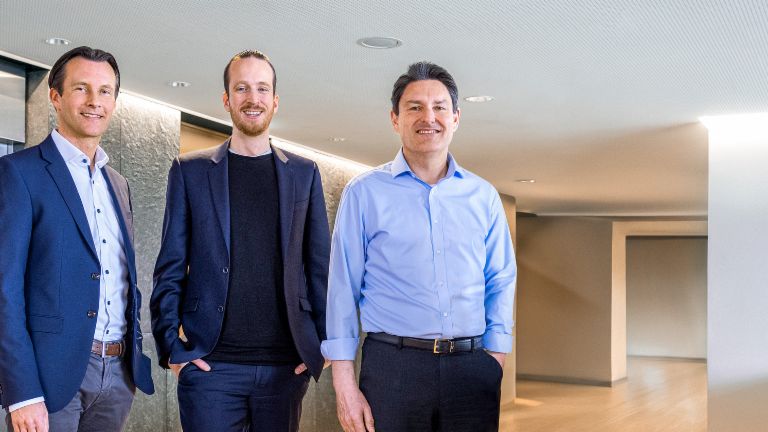Chatbots in debt collection service: Tom and Lea never sleep.
To ensure faster processing of customer issues, many companies nowadays are using chatbots. At EOS too, chatbots are giving defaulting payers information and thus providing support to service personnel.
- At EOS, chatbots are handling simple debt collection matters and informing defaulting payers about their payment status.
- The chatbots answer automated standard queries and also support customer service personnel outside business hours.
- When processing and passing on personal information, chatbots are subject to strict data privacy regulations.
Chatbots can provide advice with online shopping, search for a suitable flight connection or order your favorite pizza for direct delivery to your home. What was being done by smartphone apps in the 2010s is the realm of digital bots and virtual assistants in the current decade. For companies, they represent a practical tool to automate their own processes and encourage interaction with their customers.
Chatbot Tom deals with standard queries.

EOS Contentia, a national subsidiary of EOS in Belgium, is also using a virtual assistant on its website to provide defaulting payers with all the important information they need. The chatbot speaks three languages, French, English and Dutch, and goes by the name Tom, a nod to the Atomium, probably one of the best-known landmarks of its Belgian homeland. “As of today, Tom is answering general questions asked by defaulting payers, about payment methods or EOS as a company, for example,” says Wesley Van de Walle, Project Manager at EOS Contentia. To ensure that no question goes unanswered, he and his team took a very close look at the kind of matters that defaulting payers had raised in the past with customer service personnel. This analysis clearly demonstrated the potential of a chatbot: In more than one in four inquiries the matter could be handled automatically without input from a customer service agent.
But before Tom could start helping his co-workers, he had to go back to school, just like a human customer service agent. “For each issue there are different questions and keywords that the chatbot first has to learn,” says Wesley. So that Tom knows what he has to say and when, Wesley and his team designed a tree diagram that mapped all relevant questions and possible follow-up questions. If in a conversation with a customer a certain keyword occurs, the bot automatically knows where to start. It then follows a kind of script prescribed by the tree diagram. To ensure that the bot gets to the right outcome quickly and reliably, possible answers are proposed to the users. And what happens if Tom occasionally fails to find the right answers? “In that case we simply adapt the script by adding the respective question and answer,” says Wesley.

Once people have got used to this technology, I am sure that it will improve the relationship between defaulting payers and us as a company.
Humans and chatbots work hand in hand
Since the rollout of the chatbot in July 2020 the number of calls to the service center has declined noticeably. Tom conducts about 300 conversations with defaulting payers per month on average. One in six of these took place outside of normal business hours. This makes the chatbot a great help to the service team, but no more. At EOS Contentia, Tom will not be replacing any of its human colleagues, says Wesley: “Many cases in the debt collection environment are too complex in any case. For example a chatbot is not able to draw up an individual payment plan.”
Rather, Tom and its human colleagues are set to work together more closely in future. With the next update, the chatbot will be linked to the EOS Contentia debt collection software. Lea, Tom’s chatbot sister, so to speak, has already undergone this step at EOS Croatia. The connection to the central collection software Kollecto+ allows the chatbot to process the personal data of the defaulting payers, offering users a whole range of additional options when interacting with the chatbot. When asked, Lea can provide information about the amount of debt, the due date and amount of the next payment, any costs incurred and a whole lot more. And if a matter exceeds Lea’s capabilities, the user is passed on to a member of the service team.

Data privacy the greatest challenge
Before Lea was allowed to start work, it first had to meet a whole range of data privacy conditions in accordance with the EU’s GDPR. “That was a whole lot of work,” recalls Igor Stojančević, project manager at EOS in Croatia. “The data have to be protected when they are transferred by the chatbot to the system and back again. Chats have to be stored securely and then deleted following payment.” To identify the chat partners beyond doubt, they have to undergo a two-factor authentication process. Firstly, Lea asks for the name, claim number and phone number of the defaulting payer. If the answers conform with the data in the system, the chat partner receives a four-digit code by email or SMS that they then have to enter into the live chat window. Only after these two hurdles have been overcome is Lea allowed to provide information about personal matters.
As well as being used on the website, the intention is for Lea to also be integrated into common messaging services in the future. The popular app Viber in Croatia will set the ball rolling, to be followed soon after by WhatsApp. Using a QR code in a letter, email or on the website, defaulting payers will have access to their preferred communication channel and can interact with the chatbot in a familiar environment.
Chatbots ensure communication and self-determination
“Once people have got used to this technology, I am sure that it will improve the relationship between defaulting payers and us as a company,” says Igor. Nobody likes to be called unexpectedly and confronted with their debts. Chatbots offer a user-friendly communication channel where defaulting payers can deal with their debt collection issues themselves around the clock. Initially in Croatia and Belgium but soon in other EOS countries too. EOS in France is already integrating chatbot Tom into its communication, while national subsidiaries in the USA, Denmark and Switzerland are also exploring the use of these virtual assistants.
Please don’t hesitate to contact us if you’d like further information.
EOS in Germany
Daniel Schenk
Head of Corporate Communications & Marketing Germany
Steindamm 71
20099 Hamburg
Germany
Photo credits: Getty Images (2)
Explore more from EOS




